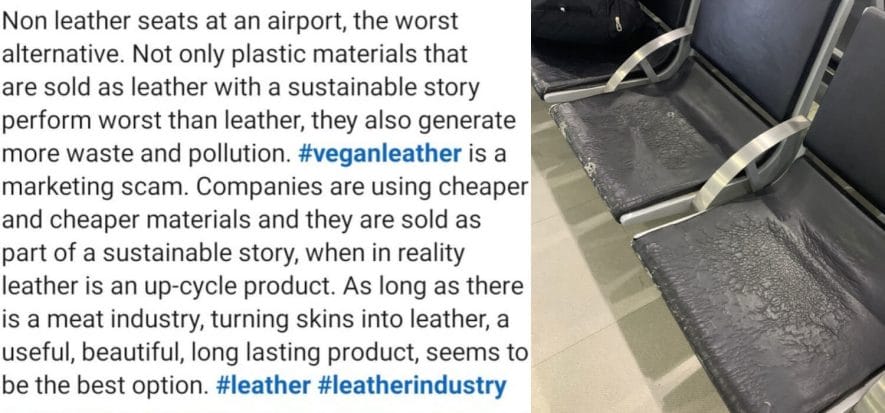The straw that breaks the camel’s back is the glance of a waiting room at an airport. The seats, covered with a material that imitates leather, are wrinkled and cracked (in the photo). As often happens with social media, the post comes from a personal experience. But the important thing is that the issue imposes itself on public opinion. Finally, on LinkedIn, there are talks about the cultural and industrial limits of the material (maliciously called) “vegan leather”. Because the outburst-post has quickly become viral, placing the web business community in the position of having to face the problem. Alternative materials, often presented as better and more sustainable, are not that.
On LinkedIn there are talks about leather
“Non-leather seats for an airport are the worst choice – reads the original post -. Plastic materials sold as an alternative perform worse than leather and generate more waste and pollution. The term vegan leather is a marketing scam”. The truth is another: “Companies use a cheaper material and present it as sustainable – it continues -. Leather, on the other hand, is circular, because it is the recovery of a waste from animal husbandry. As long as meat is consumed in the world, leather, useful, beautiful and durable, remains the best option for design”.
How was luxury able to start again earlier and better than other sectors
Luxury is restarting earlier and better than other sectors. How? Thanks to a variety of factors. One of these is roots in China. Sure, but that’s not all. Then, there are digital developments. Moreover, an adequate time to market: because a maximum of six weeks elapse between the conception of a product and its availability in the stores. For many brands, being powerful in accessories helps, as the segment is better than apparel. And in all this, the physical store does not come out weakened, on the contrary.
The sooner the better
“It has always been like this, in all crises: the luxury sector is the last to be hit and the first to recover”, explain Federico Bonelli and Armando Branchini of EY to Affari & Finanza. Even more optimistic is Claudia D’Arpizio (Bain&Co.): “Within the year, we might even be able to cancel 2020. After that, growth will be more moderate, probably in the single figure”. D’Arpizio herself claims that accessories are performing better than ready-to-wear, while the premium segment is having a harder time accelerating. Consumers are polarised: they buy fast fashion or luxury. “We are returning to the volumes of 2019. For luxury, the first quarter went well, and the second will go even better”, adds Francesco Moccagatta from the investment bank Alantra. According to him, the online is the big winner: “It currently represents 15-20% of sales, but for some very big brands it reaches 30%”.
The strength of the physical store
Does it mean that the boutique faces a dark future? Not at all. “Consumers are returning in crowds to stores, looking for meaning, for distractions, but above all, looking for a sense of belonging”. Erwan Rambourg claims this from Jing Daily’s columns. Rambourg himself points out that new buyers don’t buy online, “but they want to look, feel, smell and touch the product, which is often considered an investment”. The analyst cites the reopening of La Samaritaine in Paris: “The department store can be a kind of innovation laboratory for luxury in the coming months. What will also likely motivate consumers to return to physical reality, is having access to experiences they will never find online”. But the perspective remains omni-channel, concludes Rambourg: “In a moment of recovery and enthusiasm, it is possible to see all the channels doing well”.
Read also:










